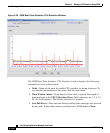
3-127
Cisco Signaling Gateway Manager User Guide
78-15589-01
Chapter 3 Managing ITP Networks Using SGM
Working with Nodes
The Note Last Updated field displays the date and time the Notes field for this
node was last updated. If there is no note currently associated with this node, this
field displays the value Not Set.
In the Notes field, enter any important information about the node, such as a
detailed description, its location, its service history, and so on. When you annotate
a node, the topology map in the Topology window displays a note icon in the
upper left corner of the node element.
At any time, you can click Cancel to exit the dialog without saving any changes.
When you are satisfied with your changes, click Save. SGM saves your changes
and updates all SGM windows to reflect your changes.
Editing SNMP IP Addresses for a Node
SGM enables you to determine which IP addresses are to be used for SNMP
polling.
To edit a node’s SNMP IP addresses, right-click an ITP node in a window, select
Edit>SNMP IP Addresses in the right-click menu. SGM displays the Edit
SNMP IP Addresses Dialog.
The IP Addresses for SNMP field lists all IP addresses associated with this ITP
node that SGM can use for SNMP polling:
• By default, SGM places all discovered IP addresses in this list, in the order
in which they are discovered. SGM uses the IP address at the top of the list as
the primary SNMP address for the node.
During SNMP polling of the node (both status polling and demand polling),
SGM first tries the primary SNMP address. If the primary is unavailable,
SGM tries the other IP addresses, one-by-one, in descending order.
• To assign a new primary SNMP address, or to change the order of the
secondary IP addresses, use the Raise Priority and Lower Priority buttons
to move the IP addresses up and down in the list.


















